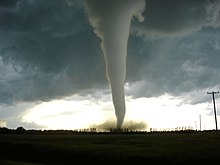 The tornado approaching the town of Elie, Manitoba around 6:50 p.m. CDT. | |
| Meteorological history | |
|---|---|
| Formed | June 22, 2007 6:25 p.m. CDT (23:25 UTC) |
| Dissipated | June 22, 2007 7:00 p.m. CDT (00:00 UTC) |
| Duration | 35 minutes |
| F5 tornado | |
| on the Fujita scale | |
| Highest winds | >260 mph (418 km/h) [1] |
| Overall effects | |
| Casualties | None |
| Damage | $39 million ($54.9 million in 2023 dollars[2]) |
| Areas affected | Elie, Manitoba, Canada |
Part of the tornado outbreaks of 2007 | |
The 2007 Elie tornado was a small but extremely powerful and erratic tornado that occurred during the evening of June 22, 2007. The powerful F5 tornado that struck the town of Elie, in the Canadian province of Manitoba (40 km (25 mi) west of Winnipeg) was known for its unusual path, how it was during its path, a rope to cone and how it is unique compared to the other F5s/EF5s.[1][3] It was part of a small two-day tornado outbreak that occurred in the area and reached a maximum width of 150 yards (140 m). The tornado was unusual because it caused the extreme damage during its roping out stage at a mere 35 yards (32 m) in width and moved extremely slowly and unpredictably. The tornado tracked primarily southeast, as opposed to the usual northeast, and made multiple loops and sharp turns.[4] Because Environment Canada adopted the Enhanced Fujita scale in 2013, there will be no more tornadoes with an F5 rating, making this tornado the first confirmed F5 tornado in Canada and the last F5 tornado in the world.[5]
While several houses were leveled, no one was injured or killed by the tornado.[1] A home in the town was swept clean off of its foundation, justifying the F5 classification. One of the strongest twisters on record since 1999, it is one of only ten to be rated F5/EF5 since 1999 in North America. The tornado caused damage of an estimated $39 million ($56.1 million in 2024).
- ^ a b c "Canada's Top Ten Weather Stories for 2007". Environment Canada Archived. Environment Canada. 30 December 2009. Retrieved 13 November 2015.
- ^ 1688 to 1923: Geloso, Vincent, A Price Index for Canada, 1688 to 1850 (December 6, 2016). Afterwards, Canadian inflation numbers based on Statistics Canada tables 18-10-0005-01 (formerly CANSIM 326-0021) "Consumer Price Index, annual average, not seasonally adjusted". Statistics Canada. Retrieved April 17, 2021. and table 18-10-0004-13 "Consumer Price Index by product group, monthly, percentage change, not seasonally adjusted, Canada, provinces, Whitehorse, Yellowknife and Iqaluit". Statistics Canada. Retrieved 2024-05-08.
- ^ "Elie tornado upgraded to highest level on damage scale - Canada's first official F5 tornado". CNW Archive. Environment Canada. Archived from the original on 17 November 2015. Retrieved 13 November 2015.
- ^ "P9.10 Elie, Manitoba, Canada, June 22, 2007: Canada's first F5 tornado (2008 - 24SLS_24sls)". ams.confex.com. Retrieved 2022-03-31.
- ^ Assessing tornado damage: EF-scale vs. F-scale Archived April 27, 2013, at the Wayback Machine